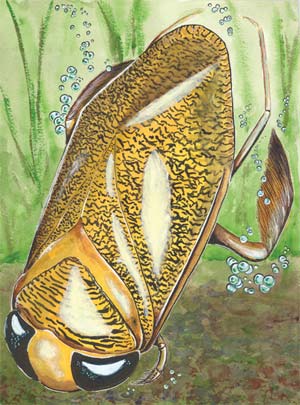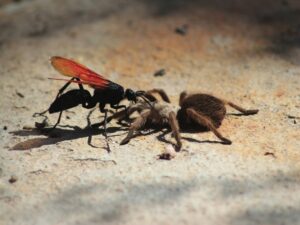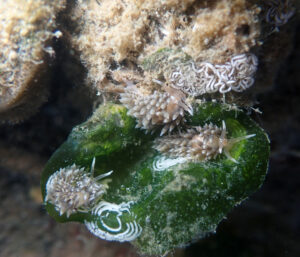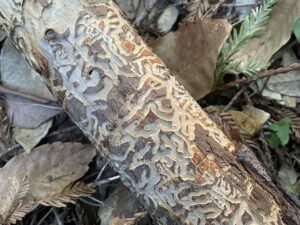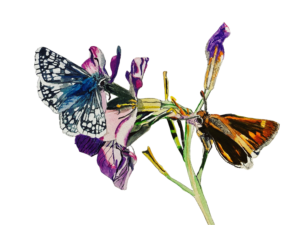By midsummer, the rushing creeks of spring have slowed down, even broken into pools. From the shade of the bank, the water seems still and lifeless, until you notice spidery forms skittering across the surface and other shapes moving along the bottom. These are the water bugs: true bugs, members of the order Hemiptera-not beetles, dragonflies, or the other full- or part-time creek residents. There are many shapes and sizes; most are voracious predators, equipped with biting and sucking mouthparts.
You’ll see water striders, known to some as Jesus bugs, gliding along the top of almost any creek or pond, their cruciform shadows tracking them below. There’s a collective name for creatures that exploit this liminal habitat: neuston, dwellers on the surface.
The surface film is not a bad place for a predator. Striders hunt both flying insects that fall into the water and aquatic types like mosquito larvae that swim up from below. Alerted by vibrations, they dash toward their prey, rowing with their middle pair of legs, then pounce and grab, mantislike, with the front pair. They inject the victim with enzymes that dissolve its innards, then suck it dry.
The surface is also a courtship arena. A male uses those versatile middle legs to send out ripples at various frequencies, alternating between one pattern that lures females and another that warns off rival males. The female lays her eggs on aquatic plants; they hatch underwater, and the fully formed nymphs swim up to begin their superficial lives.
That water-walking trick seems inherently improbable. Author Sue Hubbell got it right: “If water striders … didn’t exist and we were set the task of designing a new bug, I don’t believe we would ever come up with this one.”
Until recently, entomologists believed the tiny hairs on each leg, made water-repellent by a waxy secretion, trapped air and held water away from the foot.
But that view was challenged a couple of years ago by scientists in Beijing who found that the wax alone couldn’t account for either the leg’s water resistance or its strong supporting force. They say the secret is in the hairs themselves, each less than two thousandths of an inch long. Scanning electron microscopy has revealed that each hair, or microseta, is covered with elaborate nanoscale grooves. It’s the combination of microsetae and nanogrooves that holds the air, forming a cushion where leg meets water. The resultant buoyancy enables the striders to ride out surface turbulence; when raindrops hit the water, striders bounce. That buoyancy also allows them to pursue prey at a hundred body lengths per second. Not surprisingly, the Chinese researchers are looking into technological applications.
- Water boatman. Illustration by Christine Elder.
Water boatmen seem less likely to offer high-tech possibilities. A rare exception to the predatory nature of most water bugs, boatmen are part of the nekton, the subsurface free swimmers. A boatman’s world is the creek or pond bottom, where it siphons chlorophyll from algae and rummages through the ooze for plant matter and small organisms like rotifers. Boatmen thrive not only in local creeks and ponds, but also in extreme environments such as salt ponds and lakes acidified by mine waste.
Boatmen, which grow to about half an inch long, superficially resemble the somewhat larger backswimmers, but navigate right side up, not upside down. Rule of thumb: If it bites, it’s a backswimmer. Boatmen carry an air supply with them underwater, trapped by hairs on their underside. Like a strider, a boatman has a multifunctional tool kit of legs: scooplike forelegs, a middle pair for walking, and oarlike hind legs.
You wouldn’t expect these humble creatures to have played any significant role in human life. Historically, though, they were a major protein source for the people of central Mexico. At Lake Texcoco, floating reeds collected water boatman eggs (ahuahutle), which were dried in the sun. The eggs, likened in taste to cheese or caviar, are rich in amino acids. The adult insects were also consumed, as axayacatl. Although the lake has shrunk, ahuahutle was still being harvested as recently as the late 1980s.
California boatmen are not nearly as prolific or productive as their Mexican cousins. Unless you’re a truly dedicated forager, they’re best appreciated-like the water striders above them-as another example of the many ways of being a water bug.

.jpg)
